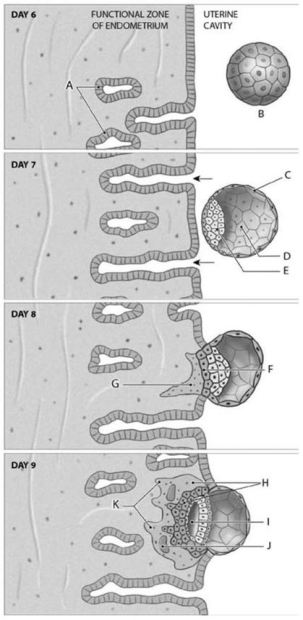A) syncytial trophoblast
B) developing villi
C) lacuna
D) uterine glands
E) amniotic cavity
Correct Answer

verified
Correct Answer
verified
Multiple Choice
Which of the following is an example of positive feedback during labor?
A) the movement of the fetus toward the cervical canal
B) the pressure the unborn exerts on the cervix
C) the distortion of the myometrium stimulates oxytocin release
D) the dilation of the cervix followed by the rupture of the amnion
E) the ejection of the placenta at the end of the placental stage
Correct Answer

verified
Correct Answer
verified
Multiple Choice
Regarding lactation and the mammary glands, which statement is true?
A) Colostrum contains more proteins than breast milk.
B) An expectant mother's mammary glands begin producing colostrum by the end of the second month of pregnancy.
C) As colostrum production increases, the mammary glands convert to milk production.
D) Colostrum, unlike milk, contains large quantities of lysozymes.
E) Colostrum has much more fat than breast milk.
Correct Answer

verified
Correct Answer
verified
Multiple Choice
If an X-carrying sperm fertilizes an egg, the resulting zygote will be
A) either male or female.
B) male only.
C) female only.
D) nonviable.
E) both male and female.
Correct Answer

verified
Correct Answer
verified
Multiple Choice
Separation of the inner cell mass from the trophoblast forms the
A) blastocoele.
B) lacunae.
C) amniotic cavity.
D) chorion.
E) allantois.
Correct Answer

verified
Correct Answer
verified
Multiple Choice
Sperm carry
A) only one X sex chromosome, exclusively.
B) only one Y sex chromosome, exclusively.
C) no sex chromosomes.
D) two Y sex chromosomes.
E) one X or one Y sex chromosome.
Correct Answer

verified
Correct Answer
verified
Multiple Choice
 Figure 20-1 Events in Implantation
Use Figure 20-1 to identify the labeled part.
-Label H represents which of the following structures?
Figure 20-1 Events in Implantation
Use Figure 20-1 to identify the labeled part.
-Label H represents which of the following structures?
A) blastocyst
B) inner cell mass
C) trophoblast
D) blastocoel
E) lacuna
Correct Answer

verified
Correct Answer
verified
Multiple Choice
Genes that appear on the X chromosome are said to be
A) X-linked.
B) autosomal recessive.
C) heterozygous.
D) homologous.
E) lethal.
Correct Answer

verified
Correct Answer
verified
Multiple Choice
The period of gestation that is characterized by rapid fetal growth and adipose tissue deposition is the ________ trimester(s) .
A) first
B) second
C) third
D) first and second
E) second and third
Correct Answer

verified
Correct Answer
verified
Multiple Choice
Regarding X-linked traits, if a father with normal color vision has children with a heterozygous mother, what percentage of the daughters will have normal color vision?
A) 0%
B) 25%
C) 50%
D) 75%
E) 100%
Correct Answer

verified
Correct Answer
verified
Multiple Choice
A relatively common inherited autosomal recessive disorder is
A) Duchenne muscular dystrophy.
B) cystic fibrosis.
C) Huntington's disease.
D) hemophilia.
E) Marfan's syndrome.
Correct Answer

verified
Correct Answer
verified
Multiple Choice
An individual who is homozygous dominant for a trait would be represented as
A) aA.
B) aa.
C) AA.
D) Aa.
E) a fusion of the different phenotypes of the given trait.
Correct Answer

verified
Correct Answer
verified
Multiple Choice
Which of the following phenotypic characteristics is an example of "codominance"?
A) normal skin pigmentation
B) hair color other than pure blond or red
C) presence of Rh factor on red blood cell membranes
D) presence of A or B antigens on red blood cell membranes
E) ability to taste phenylthiocarbamate (PTC)
Correct Answer

verified
Correct Answer
verified
Multiple Choice
The hollow cavity within the blastocyst is the
A) gastrula.
B) morula.
C) blastocoele.
D) yolk sac.
E) amnion.
Correct Answer

verified
Correct Answer
verified
Multiple Choice
The purpose of the Human Genome Project (HGP) is to
A) identify alleles for research in the field of autosomal recessive diseases.
B) describe the full set of genetic material in human chromosomes.
C) discover new methods for fingerprinting and other forensic methods.
D) create a "master race" by limiting the gene pool to carriers of desirable genes.
E) study human development and to ultimately find a way to slow down senescence.
Correct Answer

verified
Correct Answer
verified
Multiple Choice
The presence of ________ in blood or urine is a reliable indication of pregnancy.
A) estrogen and progesterone
B) luteinizing hormone
C) human placental lactogen
D) human chorionic gonadotropin
E) relaxin
Correct Answer

verified
Correct Answer
verified
Multiple Choice
The study of the development of the human organism during the first two months after fertilization is called
A) genetics.
B) embryology.
C) pediatrics.
D) anthropology.
E) gerontology.
Correct Answer

verified
Correct Answer
verified
Showing 81 - 97 of 97
Related Exams